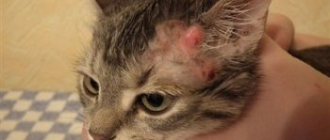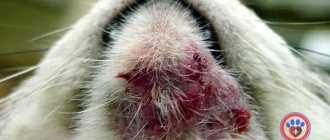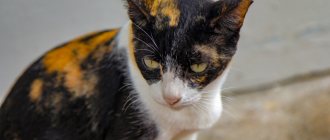Skin diseases are a common occurrence in domestic and farm animals. Pathologies manifest themselves in different ways: hair loss due to attack by parasites, problems with the epidermis and internal disorders. The causes of these symptoms need to be accurately determined. The veterinarian will not only identify the disease, but also prescribe the correct treatment. Some skin diseases can be dangerous to your pet's health.
Causes of sores throughout the body in cats
Damage to the skin is caused by sources of various types. These may be hereditary, infectious or anthropogenic (man-made) factors. The condition of the skin is affected by food changes, poor water quality, or even stress caused by moving to a new place of residence. Scabs, ulcers, and small wounds progress quickly without timely treatment. They cause the pet great discomfort and pain. The cat becomes nervous, scratching the affected areas.
Some ailments do not have obvious manifestations. It is possible to notice pathology only with a thorough examination of the animal. The most obvious is refusal to eat, apathetic state, and constant scratching. The wounds can be of different shapes and colors. They have one thing in common - this is an external manifestation of a serious internal disease.
The main factors may be:
- poor nutrition;
- genetics;
- allergies;
- bacterial and fungal infections;
- blood-sucking or intestinal parasites: ticks, fleas, worms;
- weak immune system.
This diversity means that pathology may well occur in almost any mustachioed friend. There are many specific reasons for this. A specialist in a veterinary clinic can find out the cause of the appearance of ulcers, wounds or scabs, as well as select the correct therapy.
Clinical signs
The first thing you need to pay attention to is the appearance of multiple red blisters in certain areas of the cat's skin. In place of the opened papules, brown crusts form, which subsequently turn into dry scales. Over time, they peel off from the skin and turn into scabs.
The lesions can be either minor or very extensive. With chronic dermatitis, pigmented spots and hair loss are often observed. Secondary signs that indicate that there is “something wrong” with your pet include:
- Twitching of the skin due to constant itching of varying intensity.
- The appearance of bald patches in problem areas, as the cat often itches, licks and bites itself. You can also notice broken hairs in these areas.
- Change in animal behavior. It becomes restless, aggressive, does not allow itself to be stroked and avoids any other manifestations of affection from the owner.
- The presence of excess hair in feces and vomit due to the fact that the cat intensively licks and bites the itchy skin.
Diseases with skin lesions
It is worth taking a closer look at the health problems that cause the uncharacteristic appearance of the skin and coat. Each illness negatively affects the external and internal condition of the pet.
Bacterial and fungal infections
Infections with pathogenic organisms occur in different ways. For example, the dry type of infection causes the appearance of dry, compacted crusts on the surface of the body. The wet form is characterized by redness, ulcers, scratching and severe itching. The reasons for the penetration of infections are varied:
- metabolic disorder;
- diabetes;
- neoplasms of various types;
- weakened immune system;
- superficial wounds.
Treatment is carried out only by a veterinarian after a thorough examination and laboratory tests. One of the most unpleasant and contagious lesions is lichen, which is transmitted to other animals and humans.
It is impossible to choose on your own how to treat a cat’s scratching: to do this, you need to determine the type of pathogen. This can only be done in a veterinary clinic laboratory.
Parasites in cats
One of the most common causes of wounds on a pet’s body is parasites that choose warm areas on its surface. For example, the neck and axillary parts are very attractive to them. Parasites are external blood-sucking pests - fleas or mites, including scabies).
It is not the fleas themselves that cause discomfort, but the products of their activity. The saliva released when a wound is bitten contributes to the onset of allergic irritations. The pet scratches in this area due to severe itching. This is how pathogenic microorganisms appear in the wound, which trigger complications of the disease.
Skin pests are easy to spot. To do this, you just need to examine the body and head of your mustachioed friend. If parasites appear, it is necessary to carry out timely treatment to stop the spread of the infection. In any case, it is important to consult a veterinarian. He will examine the patient and determine that the appearance of sores in the cat is indeed associated with bloodsuckers.
Ticks are much more difficult to see. Subcutaneous individuals are found only by a doctor after a thorough examination and special tests. Treatment is most often prescribed in the form of drops on the withers or tablets. The drug "Ivermek", which is used as intramuscular injections, has proven itself well. The course of injections is 30 days, during which 3 vaccinations are given with a medicinal solution.
A similar product can also be purchased in the form of an ointment or gel. It is applied to the damaged surface after consultation with a veterinarian. Do this at home strictly according to the instructions.
It is important to remember that fleas do not pose a direct threat to your pet's health, but scabies can lead to death. Ticks not only spread under the skin, but also parasitize internal organs, so it is important to start treatment as soon as possible.
Allergic manifestations in cats
Sometimes sores on a cat’s skin occur due to allergies to external irritants. For example, purchasing a new brand of industrial food can lead to malfunctions in the body, which will manifest itself in the form of skin pathologies. It is possible to determine the cause of such a reaction by visual inspection and conducting special tests to recognize the allergen.
In addition to food, the body can react to dust, chemicals or hygiene products. Even inhaling ordinary washing powder leads to unpleasant consequences. There are times when sensitive cats react to blooms. The test, performed in a hospital setting, will identify a group of foods or other substances that need to be removed from the pet. If this is not done, the cat will have to be constantly given medications.
Dermatitis in animals
There are different types of skin dermatitis. Some of them have no complications, while others lead to death if treatment is delayed. They can be both bacterial and fungal, and are also caused by mechanical damage.
The bacterial type of dermatitis manifests itself as ulcers on the body and head of the pet. Animals with weakened immune systems, as well as babies under 1 year old, are at risk of getting sick. Once the pathogen is identified, the doctor prescribes antibiotics.
Less dangerous, but just as unpleasant, are dermatitis caused by seborrhea or injury. In the first case, the cat develops dandruff, and the animal begins to constantly itch in different places. In the second case, a simple wound can fester and cause sepsis, which in many cases leads to death.
Acne on a cat's body
Acne is blackheads with hard crusts. Acne with the appearance of open and closed comedones is usually localized on the neck, chin and lips of the cat. The cause of acne is considered to be poor hygiene, infections, stress, and abnormalities in the sebaceous glands and hair follicles. Even low-quality plastic from which the bowl is made can cause acne. Contact with cheap material can cause unpleasant rashes - it all depends on the sensitivity of the individual.
Another symptom is slight hair loss. If the disease is not treated, ulcers, purulent pimples, inflammation, and bacterial infections appear. After making a diagnosis, the veterinarian prescribes antiseptic detergents: medicated shampoo, soap. In addition, lips, chin and other areas affected by acne are treated with Miramistin or Chlorhexidine.
Other lesions
Even psychogenic factors cause ulcers and crusts on a pet’s body. For example, Cushing's syndrome is manifested by baldness of certain areas of the skin. Fortunately, this syndrome is rare in pets: it appears due to too much of the hormone cortisol. The disease has other pronounced symptoms:
- strong thirst;
- frequent urination;
- constant feeling of hunger with subsequent enlargement of the abdomen;
- lethargy, muscle atrophy;
- thin skin, baldness.
Doctors often prescribe medications that can suppress large releases of cortisol into the blood. In severe cases, the pituitary gland, adrenal gland are surgically removed, or chemotherapy is used.
Another skin problem is alopecia. Loss of fur also occurs under the influence of neuroses. They can be caused by a change of place of residence, the appearance of a new owner, or meeting a new family member. Some breeds are most prone to pathology: these are Abyssinian, Himalayan and Siamese cats.
Baldness is focal. Most often it appears on the abdomen, groin area, sides or inner thighs. Sores rarely appear on a cat's neck. The medications Kot Bayun, Amitriptyline, and Stop-Stress help to cope with the problem.
Necessary diagnostics
It is quite difficult to diagnose a pet on your own. Therefore, when the first symptoms of a skin problem appear, you should contact a veterinary clinic. Only a doctor, in a laboratory setting, will be able to clarify what is causing the disease.
To confirm flea dermatitis, a white paper test is performed. The cat is thoroughly combed over the sheet, then the surface is moistened. When rusty streaks appear on the sheet, the test is considered positive. Flea feces, which look like black dots, dissolve when in contact with water and form spots on the white surface of the paper.
To identify any type of mites, scraping is necessary. Usually mites are detected immediately, but if they are absent and there are obvious signs of scabies, the scraping is repeated.
If your pet has dirt in his ears, it may be otodectosis. You should not clean your ears before visiting your veterinarian. At the clinic, a laboratory technician will take a scraping of the ear contents and examine it under a microscope.
If lichen is suspected, the laboratory will take a sample from the pet's fur and skin for the presence of fungi. Additionally, the doctor can illuminate the fur with a Wood's lamp. Typically, the spores that cause lichen emit a fluorescent glow. The effectiveness of this method is quite low, so you should not rely on its results.
Cheyletiellosis is diagnosed after examining dead scales of the epidermis. The mites that cause the disease are clearly visible even with low magnification. Therefore, you can examine them with a regular magnifying glass.
Several methods are used to diagnose Cushing's syndrome:
- analysis of morning urine to determine the cortisol-creatinine ratio;
- dexamethasone test;
- ACTH - the test is carried out before and after the administration of a synthetic ACTH substitute. The concentration of cortisol in the blood serum is calculated;
- X-rays allow you to examine all internal organs, assess their condition and size, identify tumors and metastases;
- Ultrasound is performed to measure the adrenal glands.
The danger of skin pathologies for humans
Despite the fact that such diseases are an unpleasant phenomenon, most of them are not transmitted to people. Timely and correct prescription of medications makes them not dangerous for their owners.
Infection with different types of lichen and allergic reactions from blood-sucking bites require the use of medications not only for the animal, but also for the owner. They do not pose a threat to life, but the spread of scabs and ulcers throughout the body of a person or pet is not a very pleasant phenomenon, and it needs prompt treatment.
Symptoms
With dermatitis, severe itching, soreness, redness, and the appearance of small ulcers or ulcers are observed. In advanced cases, the affected area becomes bald. An allergic reaction is manifested by similar symptoms: itching, rashes, redness. Frequent symptoms are watery eyes, nasal discharge, and peeling skin. Sometimes shortness of breath, vomiting, fever, and severe swelling develop.
With an abscess, inflammation of the skin, tumor development, general and local fever, and pain are observed. Pus oozes from the wound and there is an unpleasant odor. The wen does not cause discomfort. First, a small swelling forms, which grows very slowly. However, there is a possibility that the lump may be confused with a malignant formation, so consultation with a veterinarian is required.
Treatment of skin diseases in cats
Before visiting the hospital, you should prepare to answer questions about your mustachioed friend's condition. The doctor will definitely ask when the ulcers or scabs appeared and ask about diet and seasonal diseases. Having received complete information, the doctor will prescribe special tests and tests:
- biopsy;
- blood analysis;
- scrapings or smears;
- ultraviolet examination.
After laboratory tests, it will not be difficult to understand what caused the cat’s sores throughout the body. Often, a domestic cat is switched to a special diet containing mainly hypoallergenic foods. Vitamin and mineral complexes help restore the immune system. A course of antibiotics is most often accompanied by the use of probiotics to strengthen a weak body.
Sometimes medications can worsen a pet's condition. New symptoms or wounds begin to appear - this is an allergy to medications. In this case, the drugs are discontinued, and new medications are introduced with caution instead. The pet should be constantly monitored so as not to miss any unpleasant responses. If the cat’s condition has not worsened, then the course of therapy should be continued.
Most pet owners try to get rid of severe itching as quickly as possible. Indeed, if you eliminate this symptom, your pet will scratch the skin less and it will begin to heal. If scabs appear on the neck or head, a special collar is put on the animal. Eliminating itching without background therapy cannot be called the correct treatment, because it does not stop the root cause.
Buying medications on your own is strictly contraindicated, because this can lead to deterioration of health. Proper treatment promotes a quick recovery, and regular checks of the cat’s fur will be a good preventative measure against the spread of skin pathologies.
What to do at home?
Self-treating eczema in cats is like Russian roulette. In the best case, the owners begin to smear everything on the wounds, some drug still gives results, and the disease goes away. In the worst case, the wound not only does not go away, but begins to increase in size, becomes purulent and begins to poison the body with skin decay products, because everything is absorbed into the general bloodstream.
The best thing a person can do when they discover damaged areas of skin is to consult a veterinarian. It is very important to try to provide as much information as possible about how everything appeared, after what, during what period of time the condition with which you have already gone to the veterinary clinic developed.
After treatment is prescribed, it is important to follow all the specialist’s instructions. Therapy is usually complex, so if at least one treatment procedure is excluded, there may be no result at all.
Dry eczema
A little theory
The wound in this case is a violation of the integrity of the skin layer, affecting the underlying tissue. It can be superficial (essentially a serious scratch) or deep, affecting even the muscle layer and large vessels. In pets, such pathologies are most often the result of traumatic exposure. They occur during fights, attacks by other animals, after collisions with cyclists or cars, and also include surgical injuries that have to be inflicted on the animal during surgery. In short, there are many reasons. But in this case, it is much more important to us what happens to the wound in the future.
Its healing can occur in two types, first described by the luminary of Russian medicine, N. I. Pirogov. He distinguished between healing by primary and secondary intention. With primary intention, wounds heal only after surgery: their edges are smooth, regenerative processes start immediately. Considering that during any operation the rules of asepsis and antiseptics are strictly observed, and therefore the effect of pathogenic and conditionally pathogenic microflora is completely excluded. This happens in several stages:
Granulation. To protect itself from the penetration of microflora and debris into the wound cavity, the body begins to “darn” the wound with granulation. Fibroblasts and endothelial cells participate in the process, and new blood vessels grow from the latter.
Increasing the epidermal layer. Epithelial cells along the edges of the wound channel gradually begin to “slide” onto the upper surface of the granulation, forming a new layer of skin epidermis.
Myofibroblasts also play an important role in the healing process. It is from these cells that muscle fibers subsequently develop. They play the role of a kind of “ties”, literally tightening the edges of the former wound channel.
In principle, wound healing by secondary intention proceeds similarly, but in this case pyogenic microflora interferes with the process: complete granulation of the wound canal will not occur until all dead tissue and microbes are removed from the wound along with pus and other secretions. And it is with this process that difficulties may arise...
Itching caused by helminths
Helminths in cats Helminths not only have a pathological effect on the cat’s digestion. Worms cause loss of essential nutrients by absorbing micronutrients from the intestines. As a result of lack of nutrition, the pet's skin becomes dry, dandruff appears, and the cat licks itself much more often and more intensely, trying to get rid of the itching.
Intoxication of the animal's body with waste products and toxins produced by worms provokes an allergic reaction, skin rashes, and itching. Even a tiny kitten can suffer from helminthiasis after acquiring parasites from an adult cat. Therefore, if the kitten is itching, it is necessary to check its feces for the presence of worm eggs. The area around the anus may also itch when helminths crawl out to lay eggs. The cat then behaves characteristically - it “rides” on the carpets with its butt, relieving the itching.
Some species are transmitted through flea bites to humans. The presence of worms in kittens leads to delayed growth and development, and in pregnant cats, worm infestation can cause miscarriage. In the presence of individual individuals in the body, the disease can be asymptomatic. Fleas also transmit helminthiasis to other pets, so all inhabitants of the house need to be treated.
Medicines for helminths
If the itching is caused by worms, then it is necessary to deworm the animal. For this purpose, as prescribed by the veterinarian, the animal is given Prasitel, Pyrantel, Trontsil K, Kanikvantel, Profender, Polyvercan (sugar cubes), Panacur, Febtal, Dirofen, Milbemax, Drontal. But first you should undergo an examination and determine the type of parasite, since broad-spectrum drugs are much more toxic than those that act selectively.











